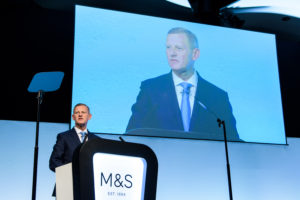M&S supply chain needs ‘significant upgrades’ warns retailer
From Logistics Manager Magazine,
Published Wednesday 3 April 2019 2:59 pm
Marks & Spencer’s supply chains in both Clothing &
Home and in Food require significant upgrades, the retailer told
investors when it revealed a 62 per cent fall in pre-tax profit for the
year to 31st March.
It said that its online fulfilment centre at Castle Donington has
struggled to cope with peak demand and some of the company’s systems are
dated.
Chief executive Steve Rowe said: “There are a number of structural
issues to address and we are taking steps towards fixing these. The new
organisation will largely be in place by July and the team is now
tackling transforming our culture to make M&S a faster, lower cost,
more commercial, more digital business.
“This is vital as we start to leverage the strength of the M&S
brand and values across a family of businesses to deliver sustainable,
profitable growth in three to five years.”
The retailer has already set out plans to accelerate its store
closure programme, which now involves closing more than 100 stores by
2022.
The retailer said: “Although our online sales are growing, our online
capability is behind the best of our competitors and our web site is
too slow. Our fulfilment centre at Castle Donington has struggled to
cope with peak demand and some of our systems are dated. In both
businesses we need to revitalise our ranges and reassert our reputation
for value for money.
“The website is being improved and we are investing to increase and
improve e-commerce capacity, including at our Castle Donington site to
support our ambition to double the online share of our Clothing &
Home sales to over 33 per cent.
“We are also building a new retail distribution centre at Welham
Green. Teams have been established to address the supply chain issues in
both main businesses, to deliver a faster, lower cost network.”
Marks & Spencer’s group revenue was up 0.7 per cent at £10.7 billion, but pre-tax profit was down 62 per cent at £66.8m.
Rowe said: “The first phase of our transformation plan, restoring the
basics, is now well under way and the actions taken have increased the
velocity of change running through our business. These changes come with
short term costs which are reflected in today’s results.”
Operating costs in distribution and warehousing were up 3.5 per cent
at £538m, “largely driven by by inflation, volume and the cost of
channel shift”.

M&S chief executive Steve Rowe.
Capital expenditure on supply chain was £23.8 million for the year –
down from £34m the year before. The company said this reflected the
completion of larger projects such as the Bradford distribution centre
in the previous year.
“During the second half we began investment in the new Welham Green
distribution centre as we move towards completing our single tier
network for Clothing & Home.”
For the year ahead, it said: “In Clothing & Home we expect a year
end space reduction of some five per cent as we accelerate our
programme to close less productive stores. We anticipate gross margin to
be level to up 50 bps, with the first half of the year adversely
affected by currency and sale timing.
“In Food, we expect year end space to be broadly level, as we open
new Simply Food stores, but close less productive Full Line space. We
anticipate gross margin to decrease by between 0 and 50 bps, with the
combination of price investment and the annualisation of input cost
inflation in the first half of the year.
“We expect UK costs to decrease by up to one per cent, as a result of
cost efficiencies and lower depreciation offsetting the costs of new
space, channel shift and inflation.
“The effective tax rate on profit before tax and adjusting items is expected to be around 22 per cent.
“Capital expenditure is expected to be c.£350-400m.”


